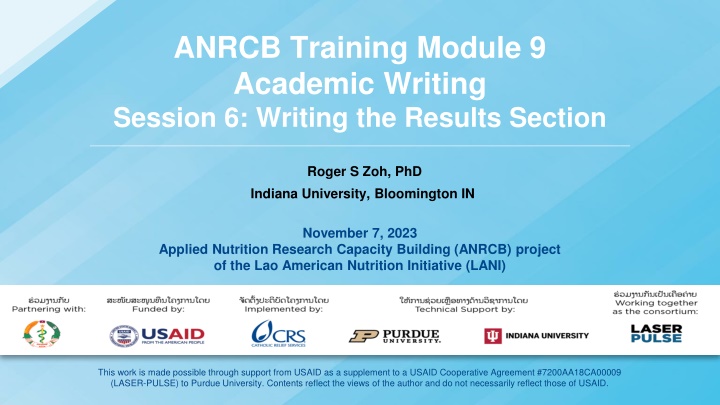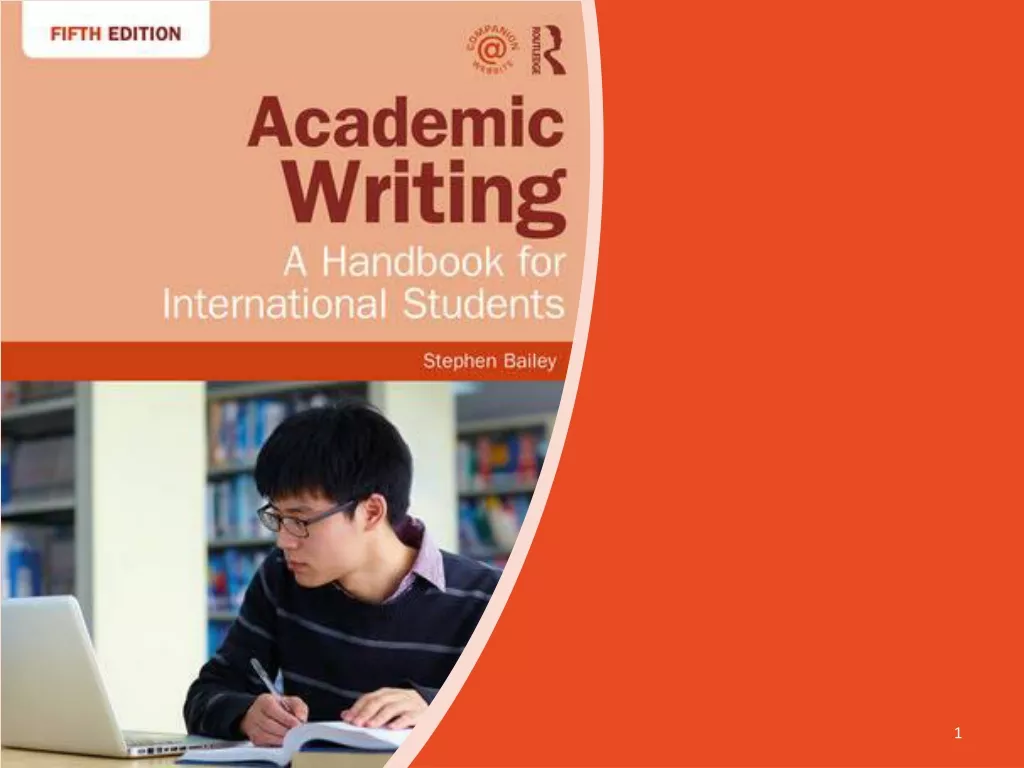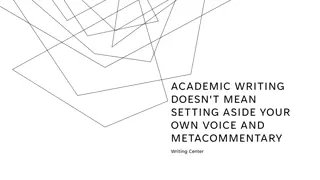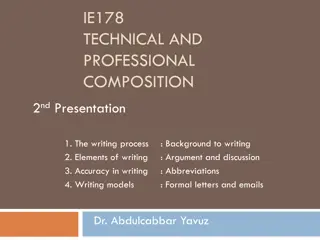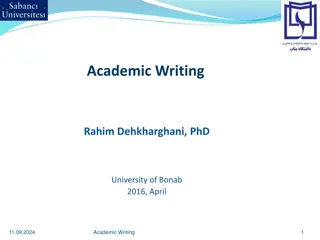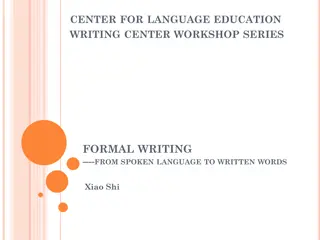ANRCB Training Module 9 Academic Writing
The results section in academic writing is pivotal as it presents key findings and sets the stage for further analysis. Learn what to include, avoid, and how to structure this essential component effectively.
Download Presentation

Please find below an Image/Link to download the presentation.
The content on the website is provided AS IS for your information and personal use only. It may not be sold, licensed, or shared on other websites without obtaining consent from the author.If you encounter any issues during the download, it is possible that the publisher has removed the file from their server.
You are allowed to download the files provided on this website for personal or commercial use, subject to the condition that they are used lawfully. All files are the property of their respective owners.
The content on the website is provided AS IS for your information and personal use only. It may not be sold, licensed, or shared on other websites without obtaining consent from the author.
E N D
Presentation Transcript
ANRCB Training Module 9 Academic Writing Session 6: Writing the Results Section Roger S Zoh, PhD Indiana University, Bloomington IN November 7, 2023 Applied Nutrition Research Capacity Building (ANRCB) project of the Lao American Nutrition Initiative (LANI) This work is made possible through support from USAID as a supplement to a USAID Cooperative Agreement #7200AA18CA00009 (LASER-PULSE) to Purdue University. Contents reflect the views of the author and do not necessarily reflect those of USAID.
Outline Results section: What is it? What to avoid in the results section Case study Some pointers ANRCB | 2
Results Section: What is it? The results section of a research paper is: 1) The section that answers the basic question What did you learn/find in your research? 2) Where you report the findings of your study based upon the information gathered as results of the methodology/approaches you applied 3) That appears generally third in the section sequence in most scientific papers (between Methods & Material and Discussion combine Results & Discussion) 4) Sets up the reader for later interpretation and evaluation in the Discussion section ANRCB | 3
Results Section: What is it? The results section should 1. Simply state the findings 2. Without bias 3. Or exaggerated interpretation 4. Arranged in logical sequence 5. Must be Included if data were generated, analyzed, or both ANRCB | 4
Example ANRCB | 5
Results Section: What is it? Findings maybe reported as 1. Written text 2. Tables 3. Graphs 4. Other illustrations ANRCB | 6
Results Section: What is it? - Findings as written test (1) For most research paper formats, there are two ways of presenting and organizing the results. 1) Present the results followed by a short explanation of the findings. For example, you may have noticed an unusual correlation between two variables during the analysis of your findings. It is correct to point this out in the results section. However, speculating as to why this correlation exists, and offering a hypothesis about what may be happening, belongs in the discussion section of your paper. 2) Present a section and then discuss it, before presenting the next section then discussing it, and so on. This is more common in longer papers because it helps the reader to better understand each finding. In this model, it can be helpful to provide a brief conclusion in the results section that ties each of the findings together and links to the discussion. (only if Results & Discussion are combined) ANRCB | 7
Results Section: What is it? - Findings as written test Recommendations 1. An introductory context for understanding the results by restating the research problem that underpins the purpose of your study. 2. A summary of your key findings in a logical sequence that generally follows your methodology section. 3. In the text, a systematic description of your results, highlighting for the reader observations that are most relevant to the topic under investigation 4. Use of the past tense when referring to your results. 5. Length ANRCB | 8
Example: Results Section: What is it? - Findings as written test ANRCB | 9
Results Section: What is it? - Graph, Tables, and Others Tables and figures should be numbered according to the order in which they are mentioned in the main text of the paper Information in figures should be relatively self-explanatory (with the aid of captions). Use tables and figures as a focal point to tell a clear and informative story about your research and avoid repeating information. Figures clarify and enhance the text but cannot replace it. ANRCB | 10
Example: Results Section: What is it? - Findings as written test ANRCB | 11
Results Section: What is it? - Graph, Tables, and Others Ogilvie AR, Schlussel Y, Sukumar D, Meng L, Shapses SA. Higher protein intake during caloricrestriction improves diet quality and attenuates loss of lean body mass. Obesity (Silver Spring). 2022;30:1411 1419. doi:10.1002/oby.23428 ANRCB | 12
Results Section: What is it? - Graph, Tables, and Others Ogilvie AR, Schlussel Y, Sukumar D, Meng L, Shapses SA. Higher protein intake during caloricrestriction improves diet quality and attenuates loss of lean body mass. Obesity (Silver Spring). 2022;30:1411 1419. doi:10.1002/oby.23428 ANRCB | 13
Another example: Any Comments? Figure 4. Progression-free survival of Groups A and B. There was no significant difference between them (27 vs. 28 months, p = 0.70). Group A underwent blood and urine M-protein evaluation every month. Group B underwent blood and urine M-protein evaluation at least every 2 months. https://doi.org/10.1002/cdt3.99 (Chronic Diseases and Translational Medicine) ANRCB | 14
One more example: Comments? ANRCB | 15
Results Section: What it to avoid. 1. Discussing or interpreting your results. Save all this for the next section of your paper, although where appropriate, you should compare or contrast specific results to those found in other studies [e.g., "Similar to Smith [1990], one of the findings of this study is the strong correlation between motivation and academic achievement...."]. 2. Reporting background information or attempting to explain your findings; this should have been done in your Introduction section, but don't panic! Often the results of a study point to the need to provide additional background information or to explain the topic further, so don't think you did something wrong. Revise your introduction as needed. 3. Ignoring negative results. If some of your results fail to support your hypothesis, do not ignore them. Document them, then state in your discussion section why you believe a negative result emerged from your study. Note that negative results, and how you handle them, often provides you with the opportunity to write a more engaging discussion section, therefore, don't be afraid to highlight them. 4. Including raw data or intermediate calculations. Ask your professor if you need to include any raw data generated by your study, such as transcripts from interviews or data files. If raw data is to be included, place it in an appendix or set of appendices that are referred to in the text. 5. Be as factual and concise as possible in reporting your findings. Do not use phrases that are vague or non-specific, such as, "appeared to be greater or lesser than..." or "demonstrates promising trends that...." 6. Presenting the same data or repeating the same information more than once. If you feel the need to highlight something, you will have a chance to do that in the discussion section. 7. Confusing figures with tables. Be sure to properly label any non-textual elements in your paper. If you are not sure, look up the term in a dictionary. ANRCB | 16
Case Study: Helping Maikho and Roger write their paper Question: What factors are associated with breastfeeding practice among mothers in Laos, PDR? Title: Factors associated with the effectiveness of Breastfeeding Protection, Promotion and Prevalence of Breastfeeding during and after Covid19 in Laos, PDR Factors (Categorical/Numeric) Prevalence of Consistent Breastfeeding (YES/NO) ANRCB | 17
Variable Mother Age (Yr) N N = 1001 31.0 (27.9, 34.3) 100 100 0.98 (0.40, 1.73) Kid Age (Yr) First table: ANC History (Number) 100 8.00 (6.75, 10.00) 100 Gender Female 47 (47%) Male 53 (53%) Should we include this table in the paper, why and why not? 100 District Keoudom 25 (25%) Phonehong 24 (24%) Thoulakhom 25 (25%) Viengkham 26 (26%) 100 0.50 (0.15, 1.00) Sick Score Prevalence (YES) 100 73 (73%) Any comments about the the table format? 100 Mother Education fs1_higher 52 (52%) fs1_lower secondary 10 (10%) fs1_post-secondary vocational, tertiary/ diploma 15 (15%) fs1_primary 4 (4.0%) fs1_upper secondary 19 (19%) Can you recommend a title for the table? Worried About Covid19 (YES) 100 33 (33%) 100 82 (82%) Medical Advice 100 56 (56%) Friends/Family Advice 100 4 (4.0%) Others Advice 100 Delivery Type Caesarian section 11 (11%) Vaginal delivery 89 (89%) ANRCB | 18 1Median (IQR); n (%)
Characteristic MotherAge Kidsage ANC.Hist Gender N OR1 1.02 0.94 1.26 95% CI1 0.93, 1.12 0.58, 1.56 1.05, 1.53 p-value 0.7 0.8 0.019 100 100 100 100 Second Table: Female Male 1.07 0.44, 2.59 0.9 District 100 Should we include this table in the paper, why and why not? Keoudom Phonehong 1.17 0.33, 4.29 0.8 Thoulakhom 2.04 0.53, 8.87 0.3 Viengkham 0.62 0.19, 2.00 0.4 SickScore MotheEducatio 100 100 2.82 0.96, 8.82 0.066 fs1_higher Any comments about the table format? fs1_lower secondary 0.33 0.08, 1.37 0.12 fs1_post-secondary vocational, tertiary/ diploma 0.67 0.20, 2.46 0.5 fs1_primary 1.00 0.12, 21.2 >0.9 fs1_upper secondary 1.78 0.49, 8.51 0.4 WorriedAboutCovid19 100 No Yes 1.58 0.61, 4.48 0.4 Can you recommend a title for the table? MedicalAdvise FriendsFamAdvise OthersAdvise Delivery.Type 100 100 100 100 3.56 0.83 1.22, 10.5 0.33, 2.03 0.00, NA 0.019 0.7 >0.9 6,124,446 Caesarian section Vaginal delivery 0.57 0.08, 2.40 0.5 1OR = Odds Ratio, CI = Confidence Interval ANRCB | 19
MODEL? INFO:? Observations:? 100? Dependent? Variable:? Prev? Type:? Generalized? linear? model? ? ? Family:? binomial? ? ? ? Link? function:? logit? ? ? MODEL? FIT:? (3)? =? 10.99,? p? =? 0.01? Pseudo-R ? (Cragg-Uhler)? =? 0.15? Pseudo-R ? (McFadden)? =? 0.09? AIC? =? 113.66,? BIC? =? 124.08? ? ? Standard? errors:? MLE? -----------------------------------------------------------------------? ? ? ? ? ? ? ? ? ? ? ? ? ? ? ? ? ? ? ? ? ? ? ? ? ? ? ? ? ? ? ? ? ? ? ? ? ? ? ? ? ? ? ? ? ? exp(Est.)? ? ? 2.5%? ? ? 97.5%? ? ? z? val.? ? ? ? ? ? p? ----------------------------? -----------? ------? -------? --------? ------? (Intercept)? ? ? ? ? ? ? ? ? ? ? ? ? ? ? ? ? ? ? ? ? ? ? ? ? ? ? ? ? ? ? ? 0.17? ? ? 0.03? ? ? ? 1.06? ? ? ? -1.89? ? ? 0.06? ANC.Hist? ? ? ? ? ? ? ? ? ? ? ? ? ? ? ? ? ? ? ? ? ? ? ? ? ? ? ? ? ? ? ? ? ? ? ? 1.24? ? ? 1.02? ? ? ? 1.51? ? ? ? ? 2.18? ? ? 0.03? MedicalAdvise? ? ? ? ? ? ? ? ? ? ? ? ? ? ? ? ? ? ? ? ? ? ? ? ? 3.23? ? ? 1.07? ? ? ? 9.75? ? ? ? ? 2.09? ? ? 0.04? WorriedAboutCovid19Yes? ? 1.36? ? ? 0.48? ? ? ? 3.81? ? ? ? ? 0.58? ? ? 0.56? -----------------------------------------------------------------------? ? Model Fit Should we include this table in the paper, why and why not? Any comments about the table format? Can you recommend a title for the table? ANRCB | 20
Figure Should we include this figure in the paper, why and why not? Any comments about the figure format? Can you recommend a title for the figure? ANRCB | 21
Figure Should we include this figure in the paper, why and why not? Any comments about the figure format? Can you recommend a title for the figure? ANRCB | 22
Drafting a Results section Can you suggest some sentences to be included in the results section? ANRCB | 23
Some Pointers Your target journal requirements overwrite anything I told you here! Consult the guidelines or instructions that the target journal or publisher provides authors and read research papers it has published, especially those with similar topics, methods, or results to your study. Focus on key results! Sometimes less is more! The true way to learn how to do it is to do it! Use online resources to get help. ANRCB | 24
